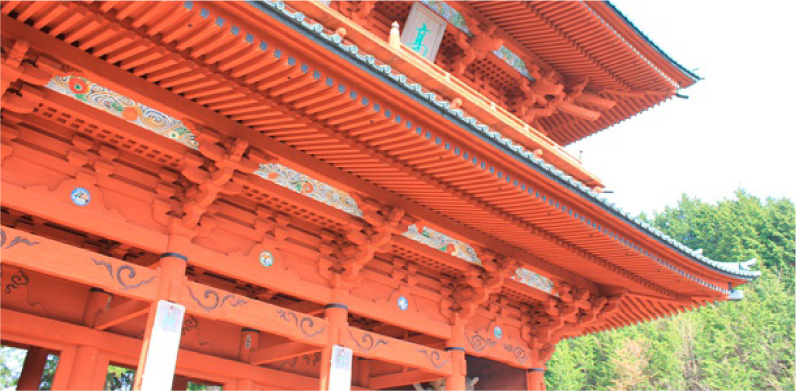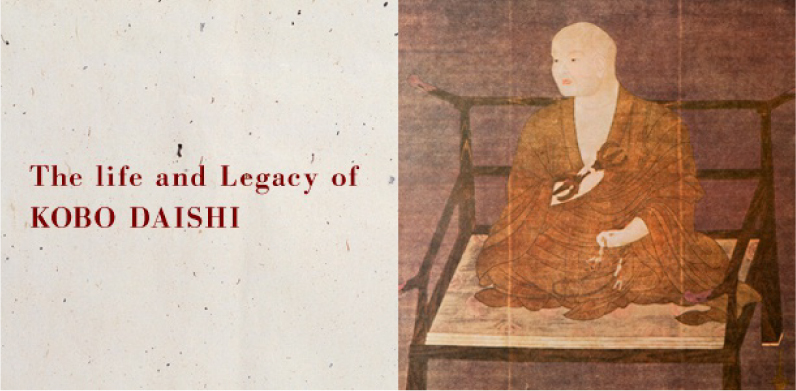About Koyasan
History of Koyasan

Koyasan is home to an active monastic center founded twelve centuries ago by the priest Kukai (posthumously known as Kobo Daishi) for the study and practice of Esoteric Buddhism. It is the headquarters of the Koyasan sect of Shingon Buddhism, a faith with a wide following throughout Japan.
Situated on a small plain at the top of Mount Koya is the sacred area known as the Danjo Garan, a complex of temples, halls, pagodas and Buddhist statuary that welcome visitors to this serene and hallowed place.
Surrounded by a thick forest of massive cedars, the area known as Okuno-in, or the Inner Sanctuary, is the setting for a vast cemetery that features the mausolea of numerous famous Japanese, including that of the samurai ruler Toyotomi Hideyoshi (or Taiko Hideyoshi) as well as memorials to the spirits of soldiers killed in the Pacific War.
WORLD HERITAGE LIST
On July 7, 2004, the United Nations Educational, Scientific and Cultural Organization (UNESCO) named Koyasan as part of the “Sacred Sites and Pilgrimage Routes in the Kii Mountain Range” to its World Heritage List. Now as in the past, Koyasan continues to attract visitors, including believers and devotees, from around the world. It is also an important destination for pilgrims returning from the “Pilgrimage to the 88 Temples of Shikoku.” Koyasan is a sacred place that always welcomes people with Buddha’s great love.
Kobo Daishi Kukai

◆ Birth
Kukai (Kobo Daishi), who is also affectionately called ‘Odaishi-sama’, was born in Sanuki province (present-day Kagawa Prefecture) in Shikoku. His father was a man named Saeki-no-Atai-
Tagimi; his mother was a member of the Ato clan. Kukai was the third son born to his devout Buddhist family.
◆ Days of Study
From around 15 years of age Kukai began his studies in history and the Chinese classics and set out for the capital at Kyoto. When he was 18, he enrolled in the national collage where he continued his education in the Chinese classics and Confucianism as a student in the Faculty of Letters (or the ‘Myogyo-ka’, as it was known at this time).
Kukai is renowned for his great talent as composer of Chinese poetry, and it is believed that his skills were developed during this period.
◆ Entering the Priesthood
While diligently engaged in his studies at this most prestigious department of the national collage, Kukai became acquainted with a Buddhist priest who gave him a copy of the esoteric scripture known as the ‘Kokuzo-Gumonji-no-ho.’ Kukai’s encounter with these teachings resulted in a transformation that would place him on an entirely different path.
Growing disappointed with the arid nature of his formal education, whose sole aim was the training of government officials, Kukai left the collage and began to devote himself to the practice of Buddhist asceticism, entering the priesthood at the age of 20.
◆ The Transmission of Esoteric Teachings
In July 804, at the age of 31, Kukai boarded the first of four ships bound for China on a diplomatic mission to T’ang Court. The small fleet, which was led by the official envoy Fujiwara-no- Kadonomaro, crossed rough seas and entered capital at Chang-an at the end of the year.
In China, Kukai visited with many learned priests at various temples. He learned about Buddhism and India, and he studied Sanskrit as well.
Through the instruction of Master Huiguo (Keika-Osyo), Kukai mastered the teachings of orthodox Esoteric Buddhism and ultimately earned the title of ‘Ajari-Henjo-Kongo,’ signifying his appointment as the Eighth Patriarch of Esoteric Buddhism. Kukai returned to Japan in 806 after a two year-stay in China. Back in his native land, he began the task of propagating the mysteries of Esoteric Buddhism throughout country.
◆ Consecration Rituals at Takaosan
In the year 811, at Kyoto’s Takaosanji Temple (present-day called Jingoji), Kukai presided over ordination rites for the eminent priest Saicho (known posthumously Dengyo Daishi). At the time, Saicho was the leader of the Tendai sect and one of Japan’s most important clergymen. By participating in an ordination ceremony conducted by Kukai, Saicho had, in effect, made himself Kukai’s disciple. At once, Kukai increased in esteem at the Imperial Court and throughout the religious community. Great numbers of people gathered one after another to become his followers. The Shingon sect of Buddhism is thought to have been established at this time.
◆ Foundation of Koyasan
In 816, the reigning Emperor Saga granted Kukai permission to establish a monastic complex at Koyasan. In that same year, Kukai ascended the mountain accompanied by numerous followers and laborers and began the work of building a center for Esoteric Buddhism. The event marks the founding of Koyasan’s Kongobuji Temple.
◆ Repairs of Manno Reservoir
In May 821, Kukai received an imperial order to supervise repair work at the Manno Resevoir in Sanuki province, where he was born.
It is believed that Kukai had acquired an advanced knowledge of civil engineering while living and studying in China. He was able to demonstrate these skills admirably by completing the difficult repair work in a mere 3 months.
◆ Establishment of Toji Temple
as a Shingon Center
In February 822, Kukai established an ordination center (known as the Shingon-in) at Nara’s Todaiji Temple. At Takaosanji Temple, he practiced the teachings of the Benevolent King’s Sutra (Ninnokyo-ho) for the peace and protection of the state. Subsequently, he conducted ordination rites for ex-emperor Heizei, presenting the retired sovereign with the special commandments of Esoteric Buddhism (Sanmaya-kai) at this time. It is also recorded that Kukai conducted similar rites for Emperor Saga in the following year.
In January 823, an imperial order entrusted Kukai with the administration of Kyoto’s Toji Temple. As abbot, Kukai subsequently transformed this temple into a center of Shingon Buddhism and focal point for propagation of this faith among the people. By imperial decree the temple was permitted to keep 50 disciples in residence. With further regulations prohibiting monks of other sects from residing at Toji, the temple was authorized to concentrate exclusively on the study of Shingon Esoteric Buddhism.
In February 824, in response to an imperial command, Kukai prayed for rain at Shinsen-en, located within the innermost precincts of the imperial palace. The following month he was appointed junior archbishop. In May of the same year, he again conducted rituals prayers for rain at the inner palace, after which he was promoted to senior archbishop.
Kukai’s Writings
Throughout the course of his busy career, Kukai wrote numerous important works.
In the Transmission of the Dharma (Fuho-den), he carefully traced the lineage and legends of the founders of orthodox Esoteric Buddhism from the Cosmic Buddha (Dainichi Nyorai) to Huiguo. Kukai also expounded the theoretical grounds of esoteric teachings in a seminal trilogy of Shingon texts known as The Principles of Attaining Enlightenment in this Existence (Sokushin-jobutsu- gi), The Principles of Sound, Meaning and Reality (Shoji-jisso-gi) and The Principles of the Mantric Syllable (Unji-gi).
Other significant works by Kukai include The Secret Treasury of Poetic Mirrors (Bunkyo-hifu- ron), The Essentials of Poetry and Prose (Bunpitsu-ganjin-sho), A Dictionary of Myriad Chinese Letters (Tenrei-bansho-meigi), The Ten Stages of the Development of the Mind (Jujushin-ron), and The Precious Key to the Sacred Treasury (Hizo-hoyaku).
In the last period of his life, Kukai composed The Secret Key to the ‘Heart Sutra’ (Hannya- shingyo-hiken).
Educational Institute
for The General Public
In 828, Kukai founded a private academy for the study of Buddhism and Confucianism called Shugei Shuchi-in at a location to the east of Toji Temple. The school was open to the general public, regardless of rank or financial means. Unfortunately, this school was forced to close after only 20 years due to a lack of funds as well as a shortage of talented personnel.
Entering Nirvana for Eternal Living
On the 21st day of March in the year 835, while construction of his monastic center continued, Kukai entered Nirvana and attained Buddhahood in this very existence at the age of 62. Afterwards, a distinguished disciple, Abbot Shinzen, assumed responsibilities for the completion of the Koyasan monastery. Since then, Koyasan has continued to flourish as a major center for the study and practice of perfect enlightenment. At present, this sacred complex of 117 temples (along with Okuno-in, etc.) serves as the spiritual and administrative center of the Shingon sect.






